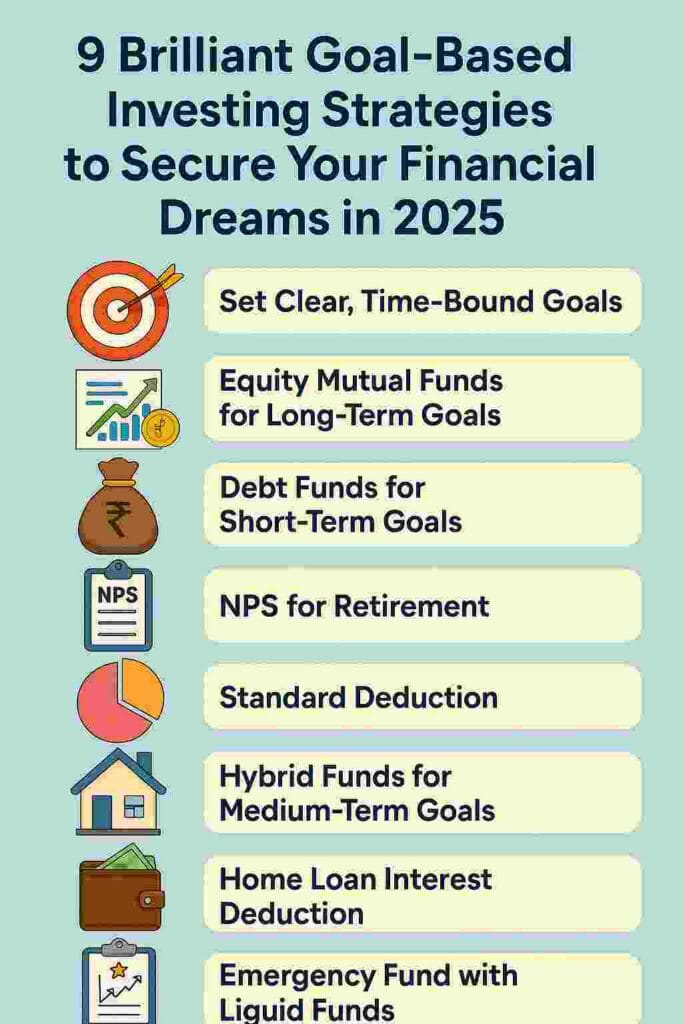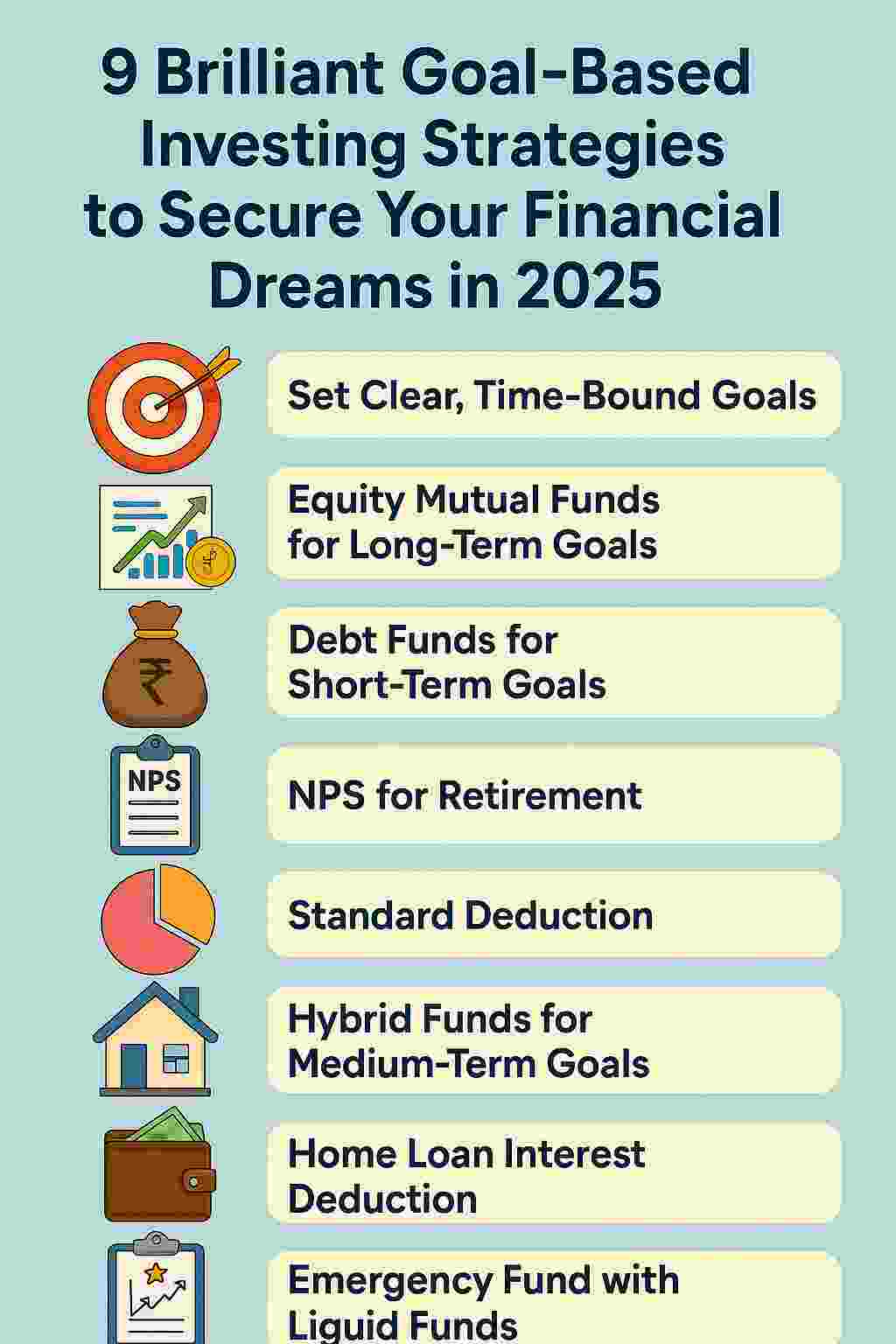Unlock 9 brilliant goal-based investing strategies for 2025 to achieve your financial dreams. Master retirement, education, and more with expert tips for wealth creation! #goal-based investing strategies, #goal based investing tips 2025, #smart investing for beginners India, #how to invest for financial goals 2025, #goal oriented investing strategies, #smart investment planning 2025, #best goal based investment plans India, #financial goals vs returns investing

Introduction: Why Goal-Based Investing Strategies Shine in 2025
The promise of large returns in 2025 frequently entices investors to place riskier wagers, but as new research highlights, the most prosperous investors prioritise staying engaged with a purpose and view wealth accumulation as a journey rather than a race. Goal-based investing strategies provide a disciplined route to financial success by matching your portfolio with life goals, such as retirement, a child’s education, or your ideal home.
The intricacy of India’s financial system, such the several slabs (0%, 5%, 12%, 18%, and 28%) under the GST regime and disagreements over classifications (e.g., popcorn at 5% loose, 12% savoury, and 18% caramelised), highlights the dangers of impulsive choices. Without a defined plan, return-driven investing might result in losses. This book reveals nine outstanding goal-based investing strategies for small business owners, independent contractors, and salaried workers in 2025. These goal-based investment techniques, which range from mutual funds to tax-efficient solutions, will increase your wealth. Together, we can take action to safeguard your financial future in 2025.
Chasing Returns Trap
Like GST’s unmet promise of simplicity, chasing high returns without a plan is a trap that scuttles wealth building. In 2025, goal-based investing strategies combat this by emphasising three distinct, time-bound goals: short-term (like a vacation), medium-term (like a down payment for a house), and long-term (like retirement) (more than seven years).
Strategy 1: Set Clear, Time-Bound Goals
Establish clear objectives with targets adjusted for inflation. For instance, with 6% inflation, a ₹20 lakh down payment for a home over five years would cost ~₹26.8 lakh. This objective is achieved by investing ₹35,000 per month in a hybrid fund with 9% returns. To establish reasonable goals for your goal-based investing strategy, use a financial calculator. Examine the planning tools.
Digital and Market Dilemmas
Similar to GST’s issues with UPI transactions and service classifications, investors face challenges in 2025 due to the digital economy and market volatility. Goal-based investing strategies use customised investment selections to overcome these obstacles:
Strategy 2: Equity Mutual Funds for Long-Term Goals
Equity mutual funds, which have historically yielded returns of 10–12%, are appropriate for long-term objectives such as retirement or school (7+ years). In ten years, a 12% monthly SIP of ₹10,000 increases to about ₹23.8 lakh. Select funds with low expense ratios and steady performance histories. Study up on mutual funds.
Strategy 3: Debt Funds for Short-Term Goals
With yields ranging from 5 to 7%, debt funds provide stability for short-term objectives like emergency savings or trips. In three years, a 6% monthly SIP of ₹12,500 will produce around ₹5.1 lakh. To reduce risk, choose funds with a short duration. Examine debt financing options.
Compliance and Planning Burdens
In 2025, private investors will face complicated investment laws similar to the GST’s E-Way Bill limits and compliance obligations. Goal-based investing strategies make planning easier with low-maintenance and tax-efficient options:
Strategy 4: National Pension System (NPS) for Retirement
With tax benefits under Section 80CCD(2) (10% of basic income for the private sector, 14% for the government) and Section 80CCD(1B) (₹50,000), NPS is a key component of goal-based investing strategies for retirement. With a 10% employer contribution (₹60,000) and a personal contribution of ₹50,000, a basic salary of ₹6 lakh can save ₹1.1 lakh in taxes. Additionally, at age 60, 60% of the corpus is tax-free. Examine the benefits of NPS.
Strategy 5: Standard Deduction for Salaried Employees
For paid workers, the ₹50,000 standard deduction can save up to ₹15,000 in taxes and requires no paperwork. For a potent goal-based investing technique, combine with NPS. Examine the tax advantages.
A Likely Hit on Wealth
In the same way that GST’s retroactive demands (₹13.4 lakh crore) damaged investor trust, unplanned investing runs the risk of eroding wealth in 2025. Savings may be reduced by market volatility or tax inefficiencies in the absence of goal-based investing strategies.
Strategy 6: Hybrid Funds for Medium-Term Goals
Hybrid funds, which balance debt and equity (8–10% returns), are appropriate for medium-term objectives such as buying a home. In five years, a 9% monthly SIP of ₹20,000 grows to around ₹15.2 lakh. For more flexibility, select funds with dynamic asset allocation. Study up on hybrid funds.
Strategy 7: Home Loan Interest Deduction
For self-occupied houses, you can claim up to ₹2 lakh under Section 24(b), which will save you ₹60,000 in taxes (30% bracket). You can improve your goal-based investing techniques by deducting the whole interest on rental properties. Examine the advantages of house loans.
Additional Strategies for 2025 Success
To complete the nine outstanding goal-based investing strategies, take into account these extra methods to protect and increase your wealth:
Strategy 8: Emergency Fund with Liquid Funds
One essential goal-based investing method is to have an emergency fund that can cover six to twelve months’ worth of costs. Liquidity is ensured by liquid funds, which provide returns of 4–6%. A ₹40,000 monthly SIP at 5% returns is needed to reach a ₹10 lakh objective in two years. Give accessibility precedence over returns. Examine liquid assets.
Strategy 9: Regular Portfolio Reviews and Rebalancing
Your portfolio may become misaligned in 2025 due to market fluctuations. Frequent evaluations (e.g., once a year) guarantee that your investments align with your objectives. For instance, if equity exposure surpasses your risk tolerance for a medium-term objective, rebalance a hybrid fund. This goal-based approach to investing helps you stay on course. Learn how to manage your portfolio.
The Way Ahead
Investors should expect more transparent financial policies when the GST Council considers rate rationalisation in 2025. Success is made possible by these nine goal-based investing strategies:
- Establish Specific Objectives: Establish short-, medium-, and long-term goals with targets adjusted for inflation.
- Equity Mutual Funds: Invest for long-term objectives (7+ years) with returns of 10–12%.
- Debt funds: Ensure short-term objectives (one to three years) with returns of five to seven percent.
- NPS for Retirement: Utilise tax benefits and 60% tax-free withdrawals with NPS for Retirement.
- Standard Deduction: Avoid any paperwork and save ₹15,000.
- Hybrid funds: Manage risk for three to seven years.
- Home Loan Interest: Home loan interest can be deducted for tax savings up to ₹2 lakh.
- Emergency Fund with Liquid Funds: Create an emergency fund with liquid funds to cover six to twelve months’ worth of costs.
- Regular Portfolio Reviews: Adjust each year to conform to investing methods based on goals.
Example: A ₹12,000 monthly SIP in an equity fund with 11% returns is needed to reach a ₹15 lakh education target in seven years. To stay ahead, start now. Examine your alternatives for investments.
Conclusion: Transform Your Wealth with Goal-Based Investing Strategies in 2025
Goal-based investing techniques in 2025 change the emphasis from chasing profits to accomplishing life objectives, making the process of building wealth a meaningful marathon. You may secure retirement, education, home purchases, and more with these nine excellent goal-based investing strategies, which include setting specific objectives, utilising mutual funds, NPS, tax-saving tools, emergency savings, and portfolio evaluations.
Avoid letting regulatory complications or market volatility throw your plans off course. Consult a financial advisor, begin putting these goal-based investing strategies into practice right now, and match your portfolio to your aspirations. Secure your financial future in 2025 by accumulating wealth with a cause!
FAQs
Q1: What are the top goal-based investing strategies for 2025?
Setting specific objectives, investing in debt funds for short-term objectives, equity funds for long-term objectives, NPS for retirement, hybrid funds, tax-saving instruments, emergency funds, and portfolio evaluations are important tactics.
Q2: How do goal-based investing strategies differ from return-driven investing?
While return-driven investing seeks large yields while frequently neglecting risk, goal-based investing concentrates on reaching specified objectives (such as buying a home) through methodical preparation.
Q3: Can NPS be part of goal-based investing strategies in 2025?
With 60% tax-free withdrawals at age 60 and tax incentives under Sections 80CCD(2) and 80CCD(1B), NPS is indeed the best option for retirement.
Q4: Which investments are appropriate for 2025 short-term objectives?
In goal-based investing strategies, debt and liquid funds, which yield returns of 4–7%, are ideal for short-term objectives (one to three years).
Q5: What effect will taxes have on 2025 goal-based investing strategies?
By lowering taxable income, tax-saving measures like the standard deduction (₹50,000) and house loan interest (₹2 lakh) improve returns.
Disclaimer
This article is not financial or investment advice; rather, it offers broad information on goal-based investing ideas for 2025. Individual circumstances differ, and financial markets and tax laws are subject to change. To customise these tactics to your requirements, speak with a qualified financial advisor or planner. Consult reputable organisations such as SEBI or the Income Tax Department to confirm investment alternatives and tax advantages.
Also Read:
- Top Investment Ideas for 2025: Navigate the Future with Confidence
- Best Time to Invest in Bonds India: Why 2025 Is the Ideal Opportunity
- Essential Factors for Investing: 10 Key Principles for Success
- Ultimate Guide: 7 Proven Ways How to Balance Strategic and Tactical Investing
- Why shifting focus from returns to goals can yield effective outcomes
- Goal-Based Mutual Fund Investing for Beginners

